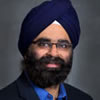ESnet Celebrates 25th Anniversary at SC11
Join Us at the Supercomputing 2011 Conference in Seattle
This SC is very special for ESnet as we mark a quarter century of serving science. Join us in the Berkeley Lab booth (512) as we celebrate our proud history and look forward to new horizons with demos, workshops, roundtables and a special toast.
Sunday, November 13
“Data Centers Have Gone Green (Or Haven't They?) When Will Networks Follow?”
Sunday, November 13, 9 a.m. – 5 p.m., Grand Hyatt Leonesa III
Organizers: Thierry Klein and Dan Kilper, Alcatel-Lucent; Inder Monga, Berkeley Lab/ESnet
Monday, November 14

Toast ESnet's 25 Years of Networking Leadership
Join us for a special event to celebrate the Energy Sciences Network's (ESnet's) silver anniversary and the launch of our 100 gigabit-per-second (Gbps) prototype network, ANI—the fastest science network in the world! Enjoy a glass of bubbly, and watch us stream 13.7 billion years of cosmic history from NERSC in Oakland, Calif. to the Berkeley Lab booth on the SC11 show room floor (details below).
When: Monday, November 14, 2011, 7 p.m.
Where: Lawrence Berkeley National Laboratory Booth 512, Washington State Convention Center Exhibit Hall
Sponsored by: Alcatel-Lucent
Demo: Visualizing the Universe at 100 Gbps
Presented by LBNL Computational Research, ESnet and NERSC, live in booth #512 at the following times:
- Monday, November 14, 7:00 -7:30 pm
- Tuesday, November 15, 10:00 -11:00 am
- Wednesday, November 16, 1:00 - 2:00 pm
- Thursday, November 17, 12:00 -12:30 pm
Approximately 13.7 billion years ago, the Universe was almost homogenous — meaning that every location in the cosmos was similar. Today, this is no longer the case. The modern Universe is rich in structures that include galaxies; clusters of gravitationally bound galaxies; galaxy super-structures called "walls" that span hundreds of millions of light-years; and the relatively empty spaces between superstructures, called voids. All the while, the Universe has been expanding, and in recent epochs the expansion rate has been accelerating.This simulation starts from a nearly homogeneous Universe and reproduces the observable properties of today’s objects. Researchers are using this data to understand how the Universe has changed over billions of years.
Performed on 4,096 cores of NERSC’s Cray XE6 “Hopper” system with the Nyx code, this simulation produced over 5 terabytes of data that will be transferred to the SC11 exhibit floor in near real-time on ESnet's brand new 100 gigabit-per-second network. ESnet's 100 Gbps network enables scientists to interactively examine large datasets at full spatial and temporal fidelity without compromising data integrity. This novel capability will enable remotely located scientists to gain insights from large data volumes located at DOE supercomputing facilities such as NERSC.
For comparison purposes, a simulation using a 10 Gbps network connection will be displayed side-by-side to showcase the vast difference in quality that a magnitude difference of bandwidth can bring to scientific discovery.
Other 100 Gbps-Powered Live Demonstrations from the SC11 Exhibit Hall
Scaling the Earth System Grid to 100 Gbps Networks
Presented by Alex Sim and Mehmet Balman (Computational Research), live in booth 512 at the following times:
- Monday, November 14, 7:30 - 8:00pm
- Tuesday, November 15, 5:00pm - 6:00pm
- Wednesday, November 16, 12:00pm - 1:00pm
- Thursday, November 17, 11:00am - 11:30am
End-to-end Circuit Service at Layer2
Presented on an ongoing basis by Inder Monga, Eric Pouyoul. and Brian Tierney, ESnet, live in booth 512.
Tuesday, November 15
Roundtable Discussion: MyESnet Portal
Real-Time Insight into Network's Inner Workings
Berkeley Lab booth 512, 1 p.m. Discussion led by John Dugan, ESnet

Jon Dugan
Roundtable Discussion: ESnet's Green Networking Initiative
Berkeley Lab booth 512, 3 p.m. Discussion led by Inder Monga, ESnet

Inder Monga
Wednesday, November 16
ESnet's ANI—Accelerating Science to 100G
Berkeley Lab Booth 512, 10:30 a.m., Steve Cotter, Department Head, ESnet

Steve Cotter
Join Steve Cotter for an in-depth discussion about ESnet's Advanced Networking Initiative (ANI). Created with a $62 million investment from the American Recovery and Reinvestment Act, ANI will give U.S Department of Energy research facilities the world's first coast-to-coast 100 Gbps network, and provide a separate nationwide experimental testbed for network research. For the first time ever, these networks will be built on top of a national fiber optic footprint that is owned and controlled by the Energy Department's research community. Upon completion, ANI will immediately give DOE research sites an immediate tenfold increase in bandwidth.
Birds of a Feather Session: “Network Measurement”
12:15 – 1:15 pm, TCC LL1
Primary Session Leader: Jon Dugan, Berkeley Lab/ESnet; Co-leader: Aaron Brown, Internet2
Birds of a Feather Session: “Network Service Interface: Providing virtualized, dynamic services over the Wide Area Network”
5:30 – 7:00 pm, TCC 205
Primary Session Leader: Inder Monga, Berkeley Lab/ESnet
Co-leaders: Tomohiro Kudoh, National Institute of Advanced Industrial Science & Technology; Guy Roberts, DANTE
Thursday, November 17
Birds of a Feather Session:“Terabit Networks: Opportunity and Challenges in Extreme-Scale Science and Massive Data Movement”
12:15PM – 1:15 p.m., TCC LL3
Primary Session Leader: Thomas Ndousse, DOE Office of Advanced Scientific Computing Research
Co-Leader: Steve Cotter, Berkeley Lab/ESnet
ESnet is Also Participating in the Co-scheduled GreenTouch Meeting
» More information: GreenTouch Members Meeting & Open Forum Session



